Multicriteria Prediction and Simulation of Winter Wheat Yield Using Extended Qualitative and Quantitative Data Based on Artificial Neural Networks
Abstract
1. Introduction
2. Materials and Methods
2.1. Method of Constructing Neural Models
2.2. Methodology for Validating the Neural Models
- RAE—relative approximation error;
- RMS—root mean square error;
- MAE—mean absolute error;
- MAPE—mean absolute percentage error;
- n—number of observations,
- —actual values obtained during research,
- —values given by the model.
2.3. Neural Network Sensitivity Analysis
3. Results
Network Sensitivity Analysis
4. Discussion
5. Conclusions
Author Contributions
Funding
Acknowledgments
Conflicts of Interest
References
- Salo, T.J.; Palosuo, T.; Kersebaum, K.C.; Nendel, C.; Angulo, C.; Ewert, F.; Bindi, M.; Calanca, P.; Klein, T.; Moriondo, M.; et al. Comparing the performance of 11 crop simulation models in predicting yield response to nitrogen fertilization. J. Agric. Sci. 2016, 154, 1218–1240. [Google Scholar] [CrossRef]
- Ruane, A.C.; Hudson, N.I.; Asseng, S.; Camarrano, D.; Ewert, F.; Martre, P.; Boote, K.J.; Thorburn, P.J.; Aggarwal, P.K.; Angulo, C.; et al. Multi-wheat-model ensemble responses to interannual climate variability. Environ. Model. Softw. 2016, 81, 86–101. [Google Scholar] [CrossRef]
- Ramirez-Villegas, J.; Koehler, A.K.; Challinor, A.J. Assessing uncertainty and complexity in regional-scale crop model simulations. Eur. J. Agron. 2017, 88, 84–95. [Google Scholar] [CrossRef]
- Gonzalez-Sanchez, A.; Frausto-Solis, J.; Ojeda-Bustamante, W. Predictive ability of machine learning methods for massive crop yield prediction. Span. J. Agric. Res. 2014, 12, 313–328. [Google Scholar] [CrossRef]
- Park, S.J.; Hwang, C.S.; Vlek, P.L.G. Comparison of adaptive techniques to predict crop yield response under varying soil and land management conditions. Agric. Syst. 2005, 85, 59–81. [Google Scholar] [CrossRef]
- Gonzalez-Sanchez, A.; Frausto-Solis, J.; Ojeda-Bustamante, W. Attribute selection impact on linear and nonlinear regression models for crop yield prediction. Sci. World J. 2014, 2014, 509429. [Google Scholar] [CrossRef]
- Kantanantha, N.; Serban, N.; Griffin, P. Yield and price forecasting for stochastic crop decision planning. J. Agric. Biol. Environ. Stat. 2010, 15, 362–380. [Google Scholar] [CrossRef]
- Cordeiro, M.; Rotz, A.; Kroebel, R.; Beauchemin, K.; Hunt, D.; Bittman, S.; Koenig, K.; McKenzie, D. Prospects of Forage Production in Northern Regions under Climate and Land-Use Changes: A Case-Study of a Dairy Farm in Newfoundland, Canada. Agronomy 2019, 9, 31. [Google Scholar] [CrossRef]
- Nelson, G.C.; Valin, H.; Sands, R.D.; Havlík, P.; Ahammad, H.; Deryng, D.; Elliott, J.; Fujimori, S.; Hasegawa, T.; Heyhoe, E.; et al. Climate change effects on agriculture: Economic responses to biophysical shocks. Proc. Natl. Acad. Sci. USA 2014, 111, 3274–3279. [Google Scholar] [CrossRef]
- Niedbała, G. Application of artificial neural networks for multi-criteria yield prediction of winter rapeseed. Sustainability 2019, 11, 533. [Google Scholar] [CrossRef]
- Niazian, M.; Sadat-Noori, S.A.; Abdipour, M. Modeling the seed yield of Ajowan (Trachyspermum ammi L.) using artificial neural network and multiple linear regression models. Ind. Crops Prod. 2018, 117, 224–234. [Google Scholar] [CrossRef]
- Emamgholizadeh, S.; Parsaeian, M.; Baradaran, M. Seed yield prediction of sesame using artificial neural network. Eur. J. Agron. 2015, 68, 89–96. [Google Scholar] [CrossRef]
- Niedbała, G. Simple model based on artificial neural network for early prediction and simulation winter rapeseed yield. J. Integr. Agric. 2019, 18, 54–61. [Google Scholar] [CrossRef]
- Wojciechowski, T.; Niedbala, G.; Czechlowski, M.; Nawrocka, J.R.; Piechnik, L.; Niemann, J. Rapeseed seeds quality classification with usage of VIS-NIR fiber optic probe and artificial neural networks. In Proceedings of the 2016 International Conference on Optoelectronics and Image Processing (ICOIP 2016), Warsaw, Poland, 10–12 June 2016; pp. 44–48. [Google Scholar]
- Niedbała, G.; Mioduszewska, N.; Mueller, W.; Boniecki, P.; Wojcieszak, D.; Koszela, K.; Kujawa, S.; Kozłowski, R.J.; Przybył, K. Use of computer image analysis methods to evaluate the quality topping sugar beets with using artificial neural networks. In Proceedings of the Proceedings of SPIE—The International Society for Optical Engineering, Bellingham, WA, USA, 3–7 April 2016; Volume 10033, p. 100332M. [Google Scholar]
- Samadianfard, S.; Nazemi, A.H.; Sadraddini, A.A. M5 Model Tree and Gene Expression Programming Based Modeling of Sandy Soil Water Movement under Surface Drip Irrigation. Agric. Sci. Dev. 2014, 3, 178–190. [Google Scholar]
- Mueller, W.; Idziaszek, P.; Boniecki, P.; Zaborowicz, M.; Koszela, K.; Kujawa, S.; Kozłowski, R.J.; Przybył, K.; Niedbała, G. An IT system for the simultaneous management of vector and raster images. In Proceedings of the Proceedings of SPIE—The International Society for Optical Engineering, Bellingham, WA, USA, 3–7 April 2016; Volume 10033, p. 100332N. [Google Scholar]
- Farjam, A.; Omid, M.; Akram, A.; Fazel Niari, Z. A neural network based modeling and sensitivity analysis of energy inputs for predicting seed and grain corn yields. J. Agric. Sci. Technol. 2014, 16, 767–778. [Google Scholar]
- Abdipour, M.; Ramazani, S.H.R.; Younessi-Hmazekhanlu, M.; Niazian, M. Modeling Oil Content of Sesame (Sesamum indicum L.) Using Artificial Neural Network and Multiple Linear Regression Approaches. JAOCS J. Am. Oil Chem. Soc. 2018, 95, 283–297. [Google Scholar] [CrossRef]
- Naroui Rad, M.R.; Koohkan, S.; Fanaei, H.R.; Pahlavan Rad, M.R. Application of artificial neural networks to predict the final fruit weight and random forest to select important variables in native population of melon (Cucumis melo Pahlavan). Sci. Hortic. 2015, 181, 108–112. [Google Scholar] [CrossRef]
- Singh, A.; Imtiyaz, M.; Isaac, R.K.; Denis, D.M. Comparison of soil and water assessment tool (SWAT) and multilayer perceptron (MLP) artificial neural network for predicting sediment yield in the Nagwa agricultural watershed in Jharkhand, India. Agric. Water Manag. 2012, 104, 113–120. [Google Scholar] [CrossRef]
- Wang, L.; Tian, Y.; Yao, X.; Zhu, Y.; Cao, W. Predicting grain yield and protein content in wheat by fusing multi-sensor and multi-temporal remote-sensing images. Field Crop. Res. 2014, 164, 178–188. [Google Scholar] [CrossRef]
- Ma, Y.; Fang, S.; Peng, Y.; Gong, Y.; Wang, D. Remote Estimation of Biomass in Winter Oilseed Rape (Brassica napus L.) Using Canopy Hyperspectral Data at Different Growth Stages. Appl. Sci. 2019, 9, 545. [Google Scholar] [CrossRef]
- Qiu, C.; Liao, G.; Tang, H.; Liu, F.; Liao, X.; Zhang, R.; Zhao, Z. Derivative Parameters of Hyperspectral NDVI and Its Application in the Inversion of Rapeseed Leaf Area Index. Appl. Sci. 2018, 8, 1300. [Google Scholar] [CrossRef]
- Armstrong, J.S.; Green, K.C.; Graefe, A. Golden rule of forecasting: Be conservative. J. Bus. Res. 2015, 68, 1717–1731. [Google Scholar] [CrossRef]
- Clemen, R.T.; Winkler, R.L. Combining probability distributions from experts in risk analysis. Risk Anal. 1999, 19, 187–203. [Google Scholar] [CrossRef]
- Makridakis, S.; Hibon, M. The M3-competition: Results, conclusions and implications. Int. J. Forecast. 2000, 16, 451–476. [Google Scholar] [CrossRef]
- Kaczmarek-Majer, K.; Hryniewicz, O. Application of linguistic summarization methods in time series forecasting. Inf. Sci. 2019, 478, 580–594. [Google Scholar] [CrossRef]
- Al-Gaadi, K.A.; Hassaballa, A.A.; Tola, E.; Kayad, A.G.; Madugundu, R.; Alblewi, B.; Assiri, F. Prediction of potato crop yield using precision agriculture techniques. PLoS ONE 2016, 11, e0162219. [Google Scholar] [CrossRef]
- Al-Hamed, S.A.; Wahby, M.F. Prediction of potato yield based on energy inputs using artificial neural networks and c-sharp under Saudi Arabia Conditions. Biosci. Biotechnol. Res. Asia 2016, 13, 631–644. [Google Scholar] [CrossRef][Green Version]
- FAO Food and Agriculture Organization of the United Nations (FAO). FAOSTAT Online Statistical Service. 2019. Available online: http://faostat.fao.org (accessed on 30 April 2019).
- Li, Z.; Song, M.; Feng, H.; Zhao, Y. Within-season yield prediction with different nitrogen inputs under rain-fed condition using CERES-Wheat model in the northwest of China. J. Sci. Food Agric. 2016, 96, 2906–2916. [Google Scholar] [CrossRef] [PubMed]
- Khoshnevisan, B.; Rafiee, S.; Iqbal, J.; Omid, M.; Badrul, N.; Wahab, A.W.A. A Comparative Study Between Artificial Neural Networks and Adaptive Neuro-Fuzzy Inference Systems for Modeling Energy Consumption in Greenhouse Tomato Production: A Case Study in Isfahan Province. J. Agric. Sci. Technol. 2015, 17, 49–62. [Google Scholar]
- Huang, N.; Li, R.; Lin, L.; Yu, Z.; Cai, G. Low redundancy feature selection of short term solar irradiance prediction using conditional mutual information and Gauss process regression. Sustainability 2018, 10, 2889. [Google Scholar] [CrossRef]
- Niedbala, G.; Kozlowski, R.J. Application of Artificial Neural Networks for Multi-Criteria Yield Prediction of Winter Wheat. J. Agric. Sci. Technol. 2019, 21, 51–61. [Google Scholar]
- Domínguez, J.A.; Kumhálová, J.; Novák, P. Winter oilseed rape and winter wheat growth prediction using remote sensing methods. Plant Soil Environ. 2015, 61, 410–416. [Google Scholar]
- Abdipour, M.; Younessi-Hmazekhanlu, M.; Ramazani, S.H.R.; Hassan Omidi, A. Artificial neural networks and multiple linear regression as potential methods for modeling seed yield of safflower (Carthamus tinctorius L.). Ind. Crops Prod. 2019, 127, 185–194. [Google Scholar] [CrossRef]
- Dar, E.A.; Brar, A.S.; Mishra, S.K.; Singh, K.B. Simulating response of wheat to timing and depth of irrigation water in drip irrigation system using CERES-Wheat model. F. Crop. Res. 2017, 214, 149–163. [Google Scholar] [CrossRef]
- van der Velde, M.; Nisini, L. Performance of the MARS-crop yield forecasting system for the European Union: Assessing accuracy, in-season, and year-to-year improvements from 1993 to 2015. Agric. Syst. 2018, 168, 203–212. [Google Scholar] [CrossRef]
- Zhang, G.P.; Patuwo, E.B.; Michael, Y.H. Forecasting with artificial neural networks: The state of the art. Int. J. Forecast. 1998, 14, 35–62. [Google Scholar] [CrossRef]
- Dias, H.B.; Sentelhas, P.C. Evaluation of three sugarcane simulation models and their ensemble for yield estimation in commercially managed fields. Field Crop. Res. 2017, 213, 174–185. [Google Scholar] [CrossRef]
- Habyarimana, E.; Piccard, I.; Catellani, M.; De Franceschi, P.; Dall’Agata, M. Towards Predictive Modeling of Sorghum Biomass Yields Using Fraction of Absorbed Photosynthetically Active Radiation Derived from Sentinel-2 Satellite Imagery and Supervised Machine Learning Techniques. Agronomy 2019, 9, 203. [Google Scholar] [CrossRef]
- John, R.P.; Megan, G. Temperatures and the growth and development of wheat: A review. Eur. J. Agron. 1999, 10, 23–36. [Google Scholar]
- Al-Kaisi, M.M.; Shanahan, J.F. Irrigation of Winter Wheat. Color. State Univ. Coop. Ext. 1999, no 0.556. Available online: https://mountainscholar.org/bitstream/handle/10217/182907/AEXT_ucsu2062205561999.pdf (accessed on 7 July 2019).
- Wanic, M.; Parzonka, M.; Załuski, D. Biodiversity of weed communities in common wheat and spelt following various forecrops. Acta Agrobot. 2018, 71. [Google Scholar] [CrossRef]

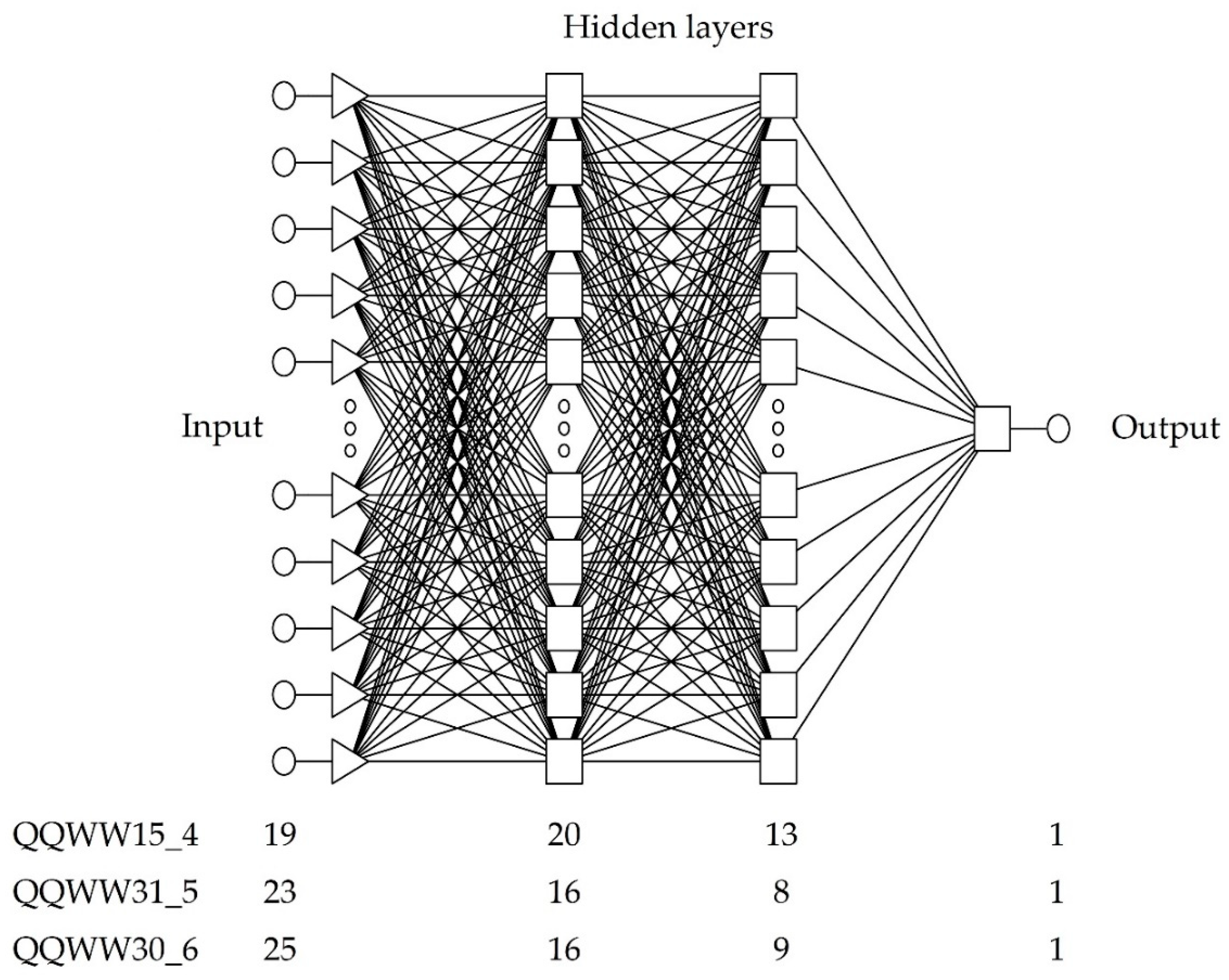
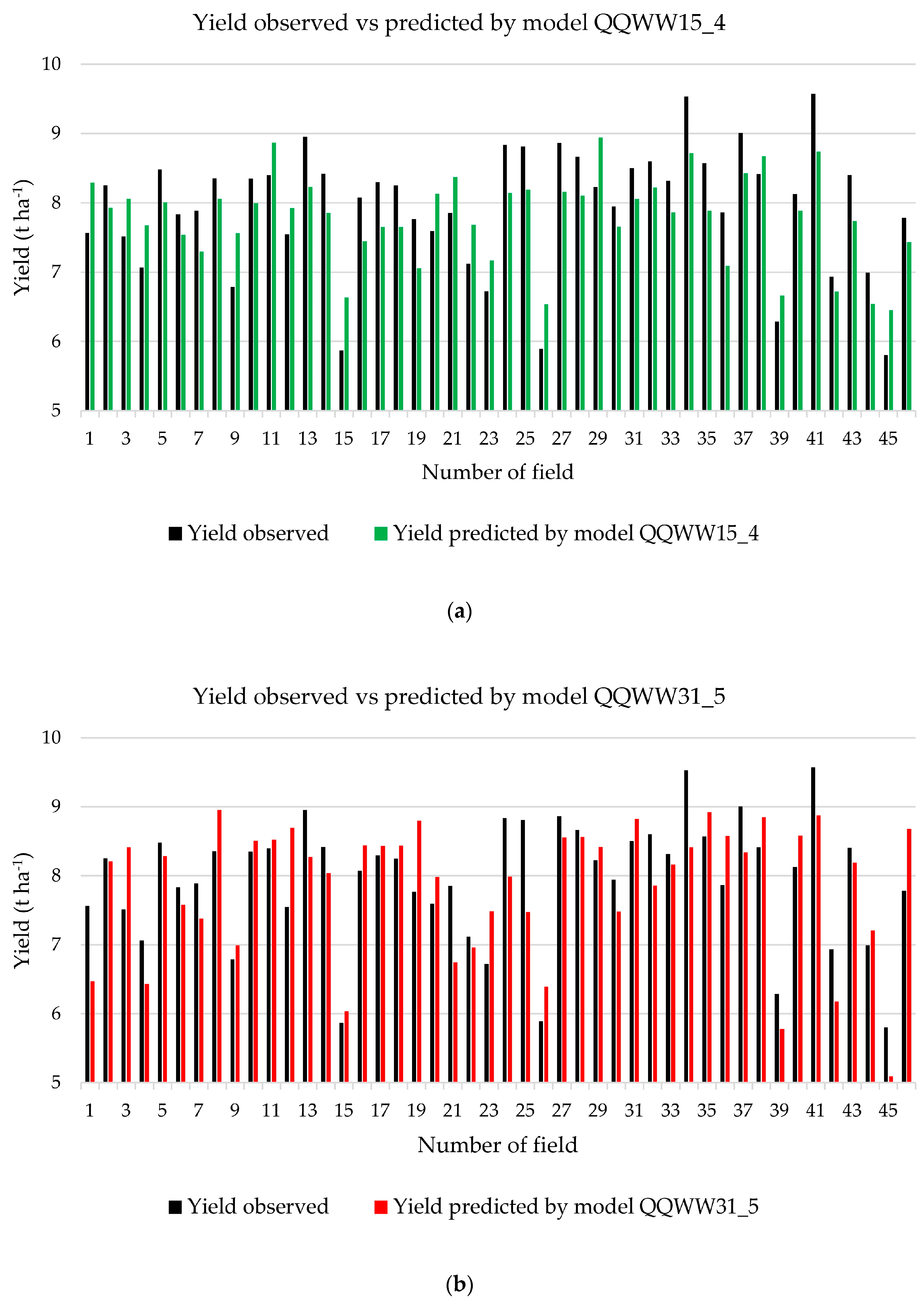
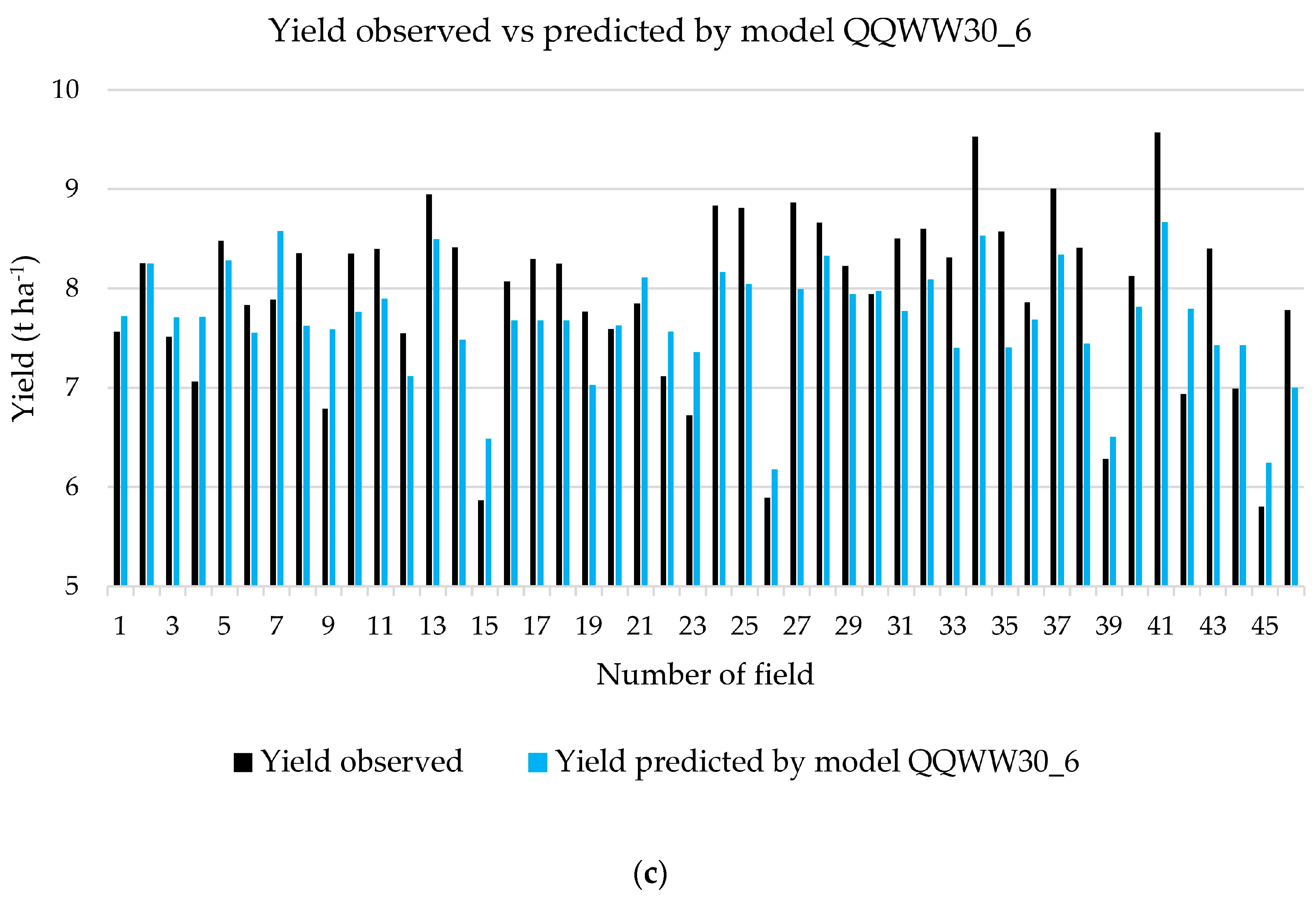
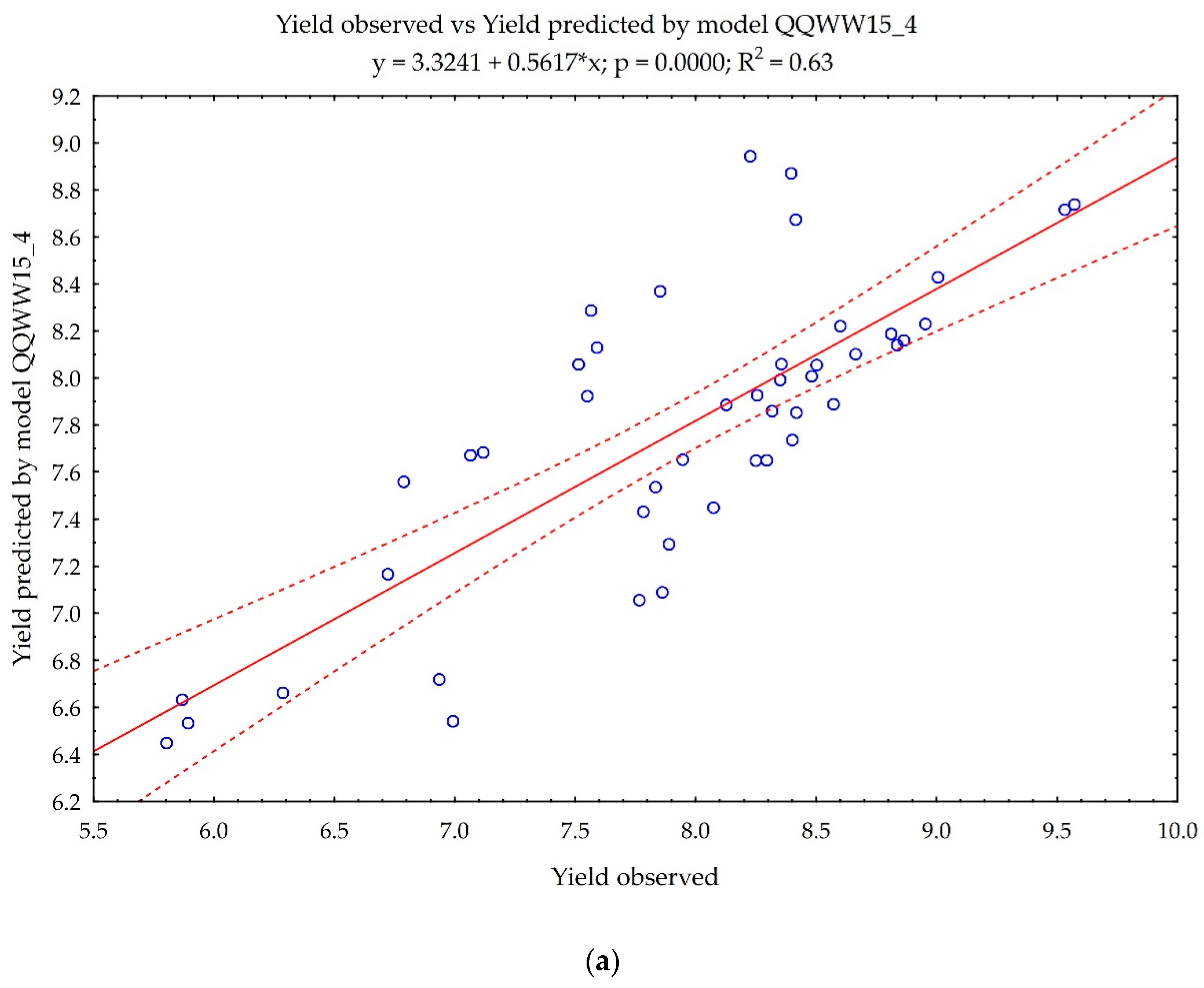
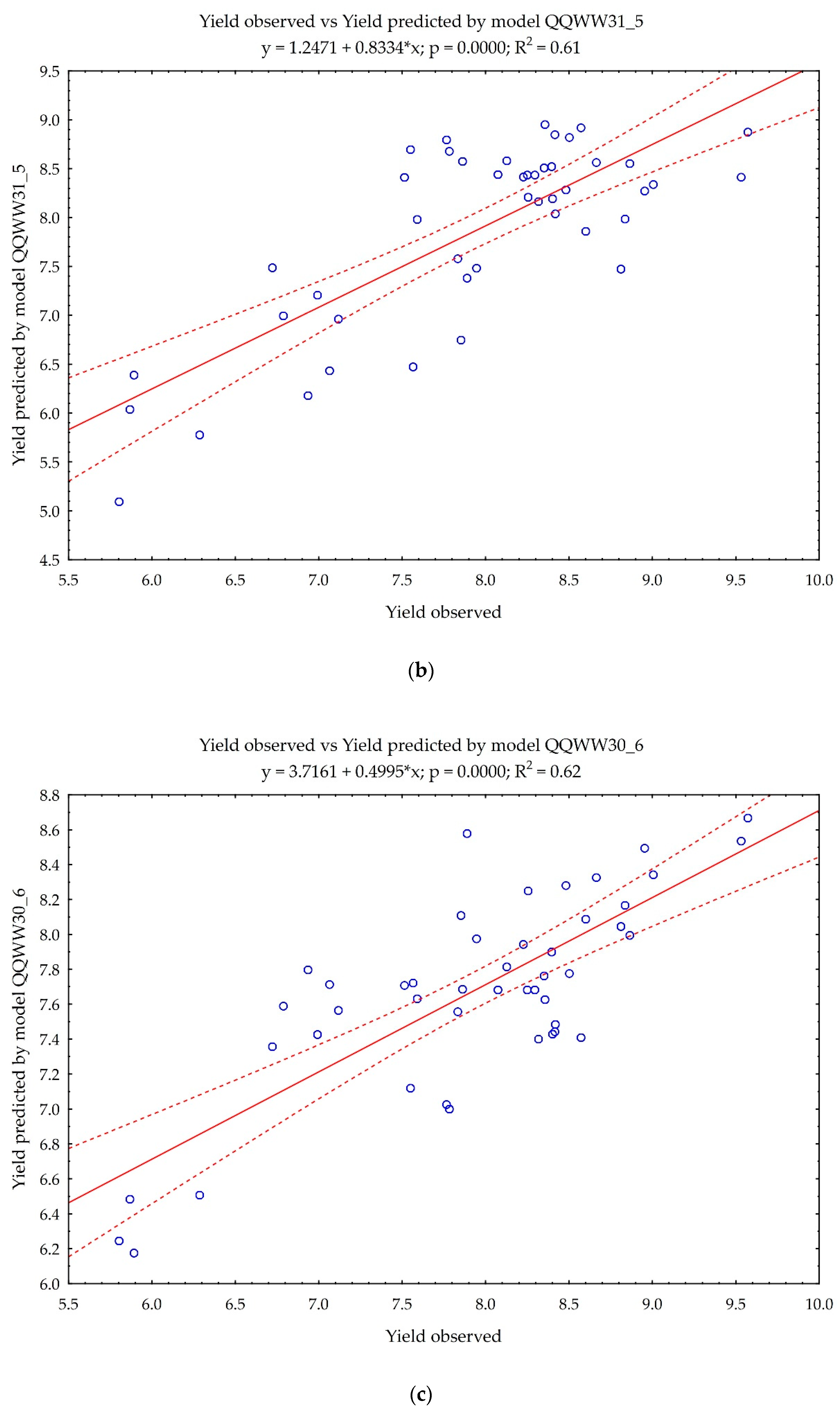
| Set A | Set B | |||||||
|---|---|---|---|---|---|---|---|---|
| Year | 2008 | 2009 | 2010 | 2011 | 2012 | 2013 | 2014 | 2015 |
| Number of fields | 37 | 34 | 36 | 51 | 15 | 30 | 52 | 46 |
| Symbol | Unit of Measure | Variable Name | Model QQWW15_4 | Model QQWW31_5 | Model QQWW30_6 | The Scope of Data |
|---|---|---|---|---|---|---|
| Quantitative Data | ||||||
| R9-12_PY | mm | The sum of precipitation from 1 September to 31 December of the previous year | + | + | + | 63–234 |
| T9-12_PY | °C | The average air temperature from 1 September to 31 December of the previous year | + | + | + | 4.9–9.4 |
| R1-4_CY | mm | The sum of precipitation from 1 January to 15 April of the current year | + | + | + | 59–185 |
| T1-4_CY | °C | The average air temperature from 1 January to 15 April of the current year | + | + | + | −0.4–4.9 |
| R4_CY | mm | The sum of precipitation from 1 April to 30 April of the current year | − | + | + | 8.7–60.4 |
| T4_CY | °C | The average air temperature from 1 April to 30 April of the current year | − | + | + | 5.9–12.2 |
| R5_CY | mm | The sum of precipitation from 1 May to 31 May of the current year | − | + | + | 14.2–132.5 |
| T5_CY | °C | The average air temperature from 1 May to 31 May of the current year | − | + | + | 11.8–16.2 |
| R6_CY | mm | Total precipitation from 1 June to 30 June of the current year | − | − | + | 15–121 |
| T6_CY | °C | The average air temperature from 1 June to 30 June of the current year | − | − | + | 14.2–19.6 |
| N_LY | kg ha−1 | The sum of N fertilization-autumn in the previous year | + | + | + | 0–100 |
| N_CY | kg ha−1 | The sum of N fertilization-spring in the current year | + | + | + | 68–359 |
| P2O5_CY | kg ha−1 | The sum of P2O5 fertilization in the current year | + | + | + | 0–82 |
| K2O_CY | kg ha−1 | The sum of K2O fertilization in the current year | + | + | + | 0–151 |
| MGO_CY | kg ha−1 | The sum of MgO fertilization in the current year | + | + | + | 0–46 |
| SO3_CY | kg ha−1 | The sum of SO3 fertilization in the current year | + | + | + | 14–115 |
| CU_CY | g ha−1 | The sum of Cu fertilization in the current year | + | + | + | 10–138 |
| MN_CY | g ha−1 | The sum of Mn fertilization in the current year | + | + | + | 40–360 |
| ZN_CY | g ha−1 | The sum of Zn fertilization in the current year | + | + | + | 9–226 |
| DOF_PY | t ha−1 | The dose of organic fertilizer in the previous year | + | + | + | 0–36 |
| Qualitative Data | ||||||
| KOF_PY | word | The kind of organic fertilizer in the previous year | + | + | + | No, Livestock manure, Chicken manure. |
| LF_PY | word | The field liming in the previous year | + | + | + | Yes, No. |
| ST_PY | word | The soil tillage in the previous year | + | + | + | Aggregate cultivator, Shallow tillage, Deep tillage, Ploughing. |
| KSD_PY | word | The kind of sowing date in the previous year | + | + | + | Early, Optimal, Tardy. |
| TF_PY | word | The type of forecrop in the previous year | + | + | + | Winter rapeseed, Winter wheat, Winter triticale, Winter barley, Spring barley, Sugar beet, Potatoes, Alfalfa, Sunflower, Mustard, Maize. |
| QQWW15_4 | QQWW31_5 | QQWW30_6 | |
|---|---|---|---|
| Neural network structure | MLP 19:35-20-13-1:1 | MLP 23:38-16-8-1:1 | MLP 25:39-16-9-1:1 |
| Learning error | 0.0579 | 0.0721 | 0.0781 |
| Validation error | 0.0707 | 0.0564 | 0.0664 |
| Test error | 0.1517 | 0.0835 | 0.0996 |
| Mean | 6.5785 | 6.5785 | 6.5785 |
| Standard deviation | 1.5707 | 1.5707 | 1.5707 |
| Average error | 0.0164 | 0.0285 | −0.0029 |
| Deviation error | 0.7188 | 0.8624 | 0.8952 |
| Mean Absolute error | 0.5041 | 0.6635 | 0.6802 |
| Quotient deviations | 0.4576 | 0.5491 | 0.5722 |
| Correlation | 0.8896 | 0.8386 | 0.8201 |
| Model | RAE (−) | RMS (t ha−1) | MAE (t ha−1) | MAPE (%) |
|---|---|---|---|---|
| QQWW15_4 | 0.069 | 0.567 | 0.542 | 6.92 |
| QQWW31_5 | 0.066 | 0.618 | 0.521 | 6.63 |
| QQWW30_6 | 0.068 | 0.619 | 0.547 | 6.88 |
| Variable | Model | |||||
|---|---|---|---|---|---|---|
| QQWW15_4 | QQWW31_5 | QQWW30_6 | ||||
| Quotient | Rank | Quotient | Rank | Quotient | Rank | |
| R9-12_PY | 1.1381 | 9 | 1.0114 | 13 | 1.0155 | 19 |
| T9-12_PY | 1.3673 | 1 | 1.0420 | 7 | 1.1622 | 2 |
| R1-4_CY | 1.2296 | 4 | 1.0070 | 18 | 1.1580 | 3 |
| T1-4_CY | 1.0476 | 13 | 1.0091 | 15 | 1.1720 | 1 |
| R4_CY | − | − | 1.0091 | 16 | 1.0049 | 23 |
| T4_CY | − | − | 1.0241 | 10 | 1.1572 | 4 |
| R5_CY | − | − | 1.1576 | 1 | 1.0986 | 6 |
| T5_CY | − | − | 1.1333 | 2 | 1.0670 | 8 |
| R6_CY | − | − | − | − | 1.0081 | 22 |
| T6_CY | − | − | − | − | 1.0604 | 10 |
| N_LY | 1.0174 | 19 | 1.0029 | 20 | 1.0027 | 24 |
| N_CY | 1.0417 | 16 | 1.0060 | 19 | 1.0021 | 25 |
| P2O5_CY | 1.0441 | 15 | 1.0847 | 5 | 1.0290 | 13 |
| K2O_CY | 1.1039 | 12 | 0.9975 | 22 | 1.0101 | 21 |
| MGO_CY | 1.1078 | 11 | 1.0109 | 14 | 1.0623 | 9 |
| SO3_CY | 1.0451 | 14 | 1.0289 | 9 | 1.0132 | 20 |
| CU_CY | 1.0307 | 17 | 1.0170 | 12 | 1.0163 | 17 |
| MN_CY | 1.1809 | 6 | 0.9943 | 23 | 1.0549 | 11 |
| ZN_CY | 1.1125 | 10 | 1.0084 | 17 | 1.1103 | 5 |
| DOF_PY | 1.0233 | 18 | 0.9976 | 21 | 1.0275 | 14 |
| KOF_PY | 1.1783 | 7 | 1.0331 | 8 | 1.0245 | 16 |
| LF_PY | 1.2359 | 3 | 1.0205 | 11 | 1.0268 | 15 |
| ST_PY | 1.2250 | 5 | 1.1155 | 3 | 1.0156 | 18 |
| KSD_PY | 1.1403 | 8 | 1.0588 | 6 | 1.0521 | 12 |
| TF_PY | 1.2590 | 2 | 1.1094 | 4 | 1.0787 | 7 |
© 2019 by the authors. Licensee MDPI, Basel, Switzerland. This article is an open access article distributed under the terms and conditions of the Creative Commons Attribution (CC BY) license (http://creativecommons.org/licenses/by/4.0/).
Share and Cite
Niedbała, G.; Nowakowski, K.; Rudowicz-Nawrocka, J.; Piekutowska, M.; Weres, J.; Tomczak, R.J.; Tyksiński, T.; Álvarez Pinto, A. Multicriteria Prediction and Simulation of Winter Wheat Yield Using Extended Qualitative and Quantitative Data Based on Artificial Neural Networks. Appl. Sci. 2019, 9, 2773. https://doi.org/10.3390/app9142773
Niedbała G, Nowakowski K, Rudowicz-Nawrocka J, Piekutowska M, Weres J, Tomczak RJ, Tyksiński T, Álvarez Pinto A. Multicriteria Prediction and Simulation of Winter Wheat Yield Using Extended Qualitative and Quantitative Data Based on Artificial Neural Networks. Applied Sciences. 2019; 9(14):2773. https://doi.org/10.3390/app9142773
Chicago/Turabian StyleNiedbała, Gniewko, Krzysztof Nowakowski, Janina Rudowicz-Nawrocka, Magdalena Piekutowska, Jerzy Weres, Robert Jacek Tomczak, Tomasz Tyksiński, and Adolfo Álvarez Pinto. 2019. "Multicriteria Prediction and Simulation of Winter Wheat Yield Using Extended Qualitative and Quantitative Data Based on Artificial Neural Networks" Applied Sciences 9, no. 14: 2773. https://doi.org/10.3390/app9142773
APA StyleNiedbała, G., Nowakowski, K., Rudowicz-Nawrocka, J., Piekutowska, M., Weres, J., Tomczak, R. J., Tyksiński, T., & Álvarez Pinto, A. (2019). Multicriteria Prediction and Simulation of Winter Wheat Yield Using Extended Qualitative and Quantitative Data Based on Artificial Neural Networks. Applied Sciences, 9(14), 2773. https://doi.org/10.3390/app9142773







